
The Enantiornithes, also known as enantiornithines or enantiornitheans in literature, are a group of extinct avialans, the most abundant and diverse group known from the Mesozoic era. Almost all retained teeth and clawed fingers on each wing, but otherwise looked much like modern birds externally. Over eighty species of Enantiornithes have been named, but some names represent only single bones, so it is likely that not all are valid. The Enantiornithes became extinct at the Cretaceous–Paleogene boundary, along with Hesperornithes and all other non-avian dinosaurs.
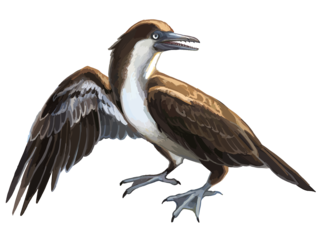
Yanornis is an extinct genus of fish-eating Early Cretaceous birds. Two species have been described, both from Liaoning province, China: Yanornis martini, based on several fossils found in the 120-million-year-old Jiufotang Formation at Chaoyang, and Yanornis guozhangi, from the 124-million-year-old Yixian Formation.
Enantiornis is a genus of Enantiornithes. The type and only currently accepted species E. leali is from the Late Cretaceous Lecho Formation at El Brete, Argentina. It was described from specimen PVL-4035, a coracoid, proximal scapula and proximal humerus found close to each other and suspected to represent the left shoulder of a single individual.
Neuquenornis volans is a species of enantiornithean birds which lived during the late Cretaceous period in today's Patagonia, Argentina. It is the only known species of the genus Neuquenornis. Its fossils were found in the Santonian Bajo de la Carpa Formation, dating from about 85-83 million years ago. This was a sizeable bird for its time, with a tarsometatarsus 46.8mm long. Informal estimates suggest that it measured nearly 30 cm (12 in) in length excluding the tail.
The Jiufotang Formation is an Early Cretaceous geological formation in Chaoyang, Liaoning which has yielded fossils of feathered dinosaurs, primitive birds, pterosaurs, and other organisms. It is a member of the Jehol group. The exact age of the Jiufotang has been debated for years, with estimates ranging from the Late Jurassic to the Early Cretaceous. New uranium-lead dates reveal the formation is deposited in the Aptian stage of the Early Cretaceous. Fossils of Microraptor and Jeholornis are from the Jiufotang.
The Iren Dabasu Formation is a Late Cretaceous geologic formation in the Iren Nor region of Inner Mongolia. Dinosaur remains diagnostic to the genus level are among the fossils that have been recovered from the formation. The formation was first described and defined by Henry Fairfield Osborn in 1922 and it is located in the Iren Nor region of China.

The Bayan Mandahu Formation is a geological unit of "redbeds" located near the village of Bayan Mandahu in Inner Mongolia and China and dates from the late Cretaceous Period. Laid down in the Campanian, it is dated somewhat uncertainly to between 75 and 71 mya.

The Yixian Formation is a geological formation in Jinzhou, Liaoning, People's Republic of China, that spans about 1.6 million years during the early Cretaceous period. It is known for its fossils, listed below.
Soroavisaurus is a genus of enantiornithean birds related to Avisaurus. It lived during the Late Cretaceous of Argentina. The only known species, S. australis, is known from fossils collected from the Lecho Formation of Estancia El Brete, in the southern tip of the province of Salta, Argentina. A binominal name of this animal means "Southern sister Avisaur".

Songlingornithidae is a family of basal euornithean dinosaurs from the Early Cretaceous of China. All known specimens come from the Jiufotang Formation and the Yixian Formation, dating to the early Barremian and Aptian ages, 125–120 million years ago.
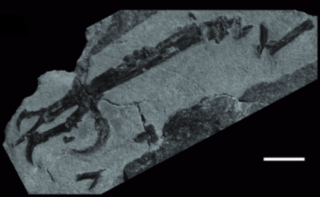
Intiornis is an extinct genus of avisaurid enantiornithean birds which existed in what is now North-West Argentina during the late Cretaceous period.

Zhouornis is an extinct genus of enantiornithine dinosaurs known from the Early Cretaceous Jehol Group of western Liaoning Province, northeastern China. Zhouornis was first named by Zihui Zhang, Luis M. Chiappe, Gang Han and Anusuya Chinsamy in 2013 and the type species is Zhouornis hani.

Bohaiornithidae is a group of early predatory enantiornithean dinosaurs from the early Cretaceous Period of China. All known specimens come from the Jiufotang Formation and Yixian Formation, dating to the early Aptian age, 125–120 million years ago. Bohaiornithidae was first coined by Wang and colleagues in 2014. They defined it as the natural group formed by all descendants of the common ancestor of the type species, Bohaiornis guoi, and Shenqiornis mengi.
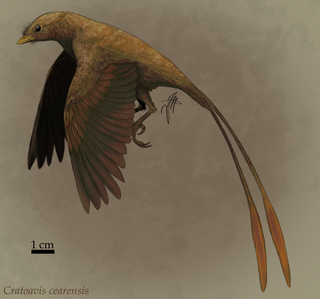
Cratoavis is a genus of enantiornithines. The type and only currently described species is C. cearensis, from the Early Cretaceous of Araripe Basin, Ceará, Brazil. The fossil, an articulated skeleton with feathers attached to the wings and surrounding the body, extends considerably the temporal record of the group at South America.

Overoraptor is an extinct genus of paravian theropod of uncertain affinities from the Late Cretaceous Huincul Formation of Argentinian Patagonia. The genus contains a single species, O. chimentoi, known from several bones of the hands, feet, and hips alongside some vertebrae.
Khinganornis is a genus of ornithuromorph dinosaurs from the Early Cretaceous Longjiang Formation of Liaoning, China. The genus contains a single species, Khinganornis hulunbuirensis, known from a nearly complete fossil preserved on a slab and counter slab. The holotype most likely represents an adult individual.

Papiliovenator is a genus of troodontid theropod dinosaur from the Bayan Mandahu Formation of Inner Mongolia, China. The type and only species is Papiliovenator neimengguensis.
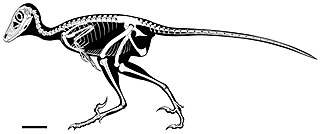
Daurlong is an extinct genus of dromaeosaurid dinosaur from the Early Cretaceous (Aptian) Longjiang Formation of China. The genus contains a single species, D. wangi, known from a nearly complete skeleton. Daurlong represents the first described occurrence of a preserved intestinal region in a theropod closely related to birds.
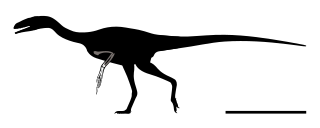
Migmanychion is an extinct genus of maniraptoran theropod dinosaur from the Early Cretaceous Longjiang Formation of China. The genus contains a single species, M. laiyang, known from an incomplete left forelimb.













